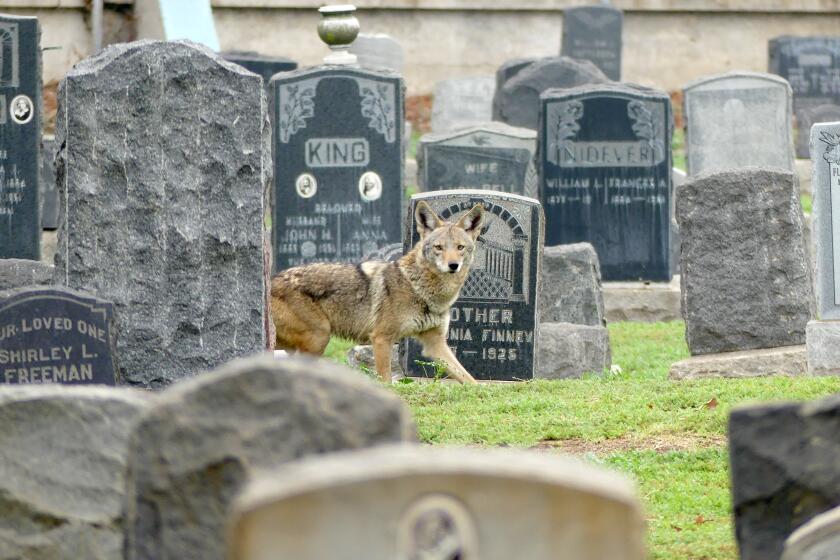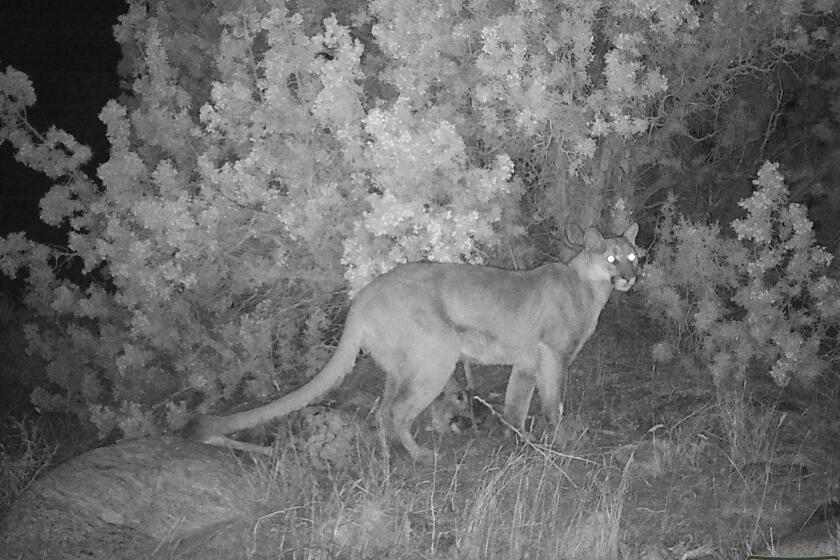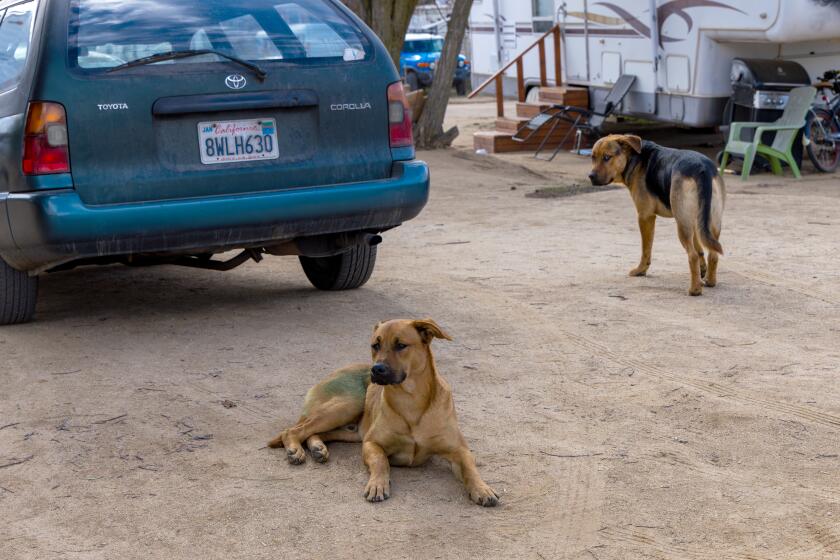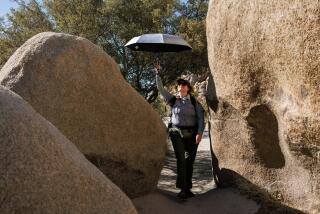- Share via
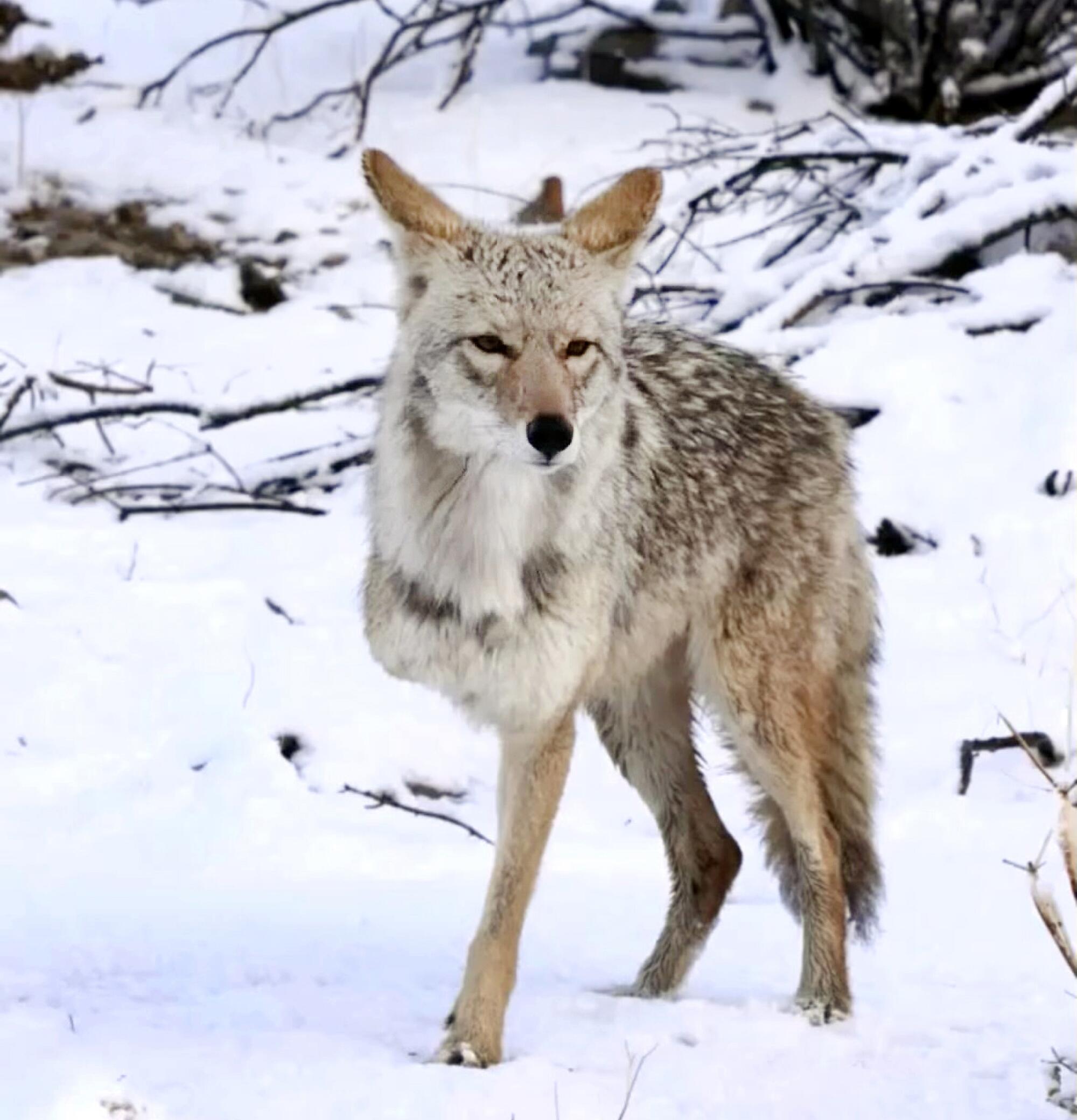
TWENTYNINE PALMS, Calif. — Rachel Crabtree was visiting Joshua Tree National Park last March when she saw something that shocked her:
In the middle of a desert snowstorm, a three-legged coyote was darting back and forth across a busy road.
The nurse whipped out her phone and videotaped the coyote as it eyed traffic and then bounded away gracefully, with just the slightest hint of a hobble.
Aggressive and impactful reporting on climate change, the environment, health and science.
Only later would Crabtree learn that the coyote called Tripod was a local legend whose likeness graces a massive mural downtown and whose chance encounters with residents are quickly documented on social media. A Tripod sighting near the park entrance can bring traffic to a grinding halt as visitors snap photos, and officials say people have been seen feeding the animal.
“Tripod probably is our most famous resident — not to put down any of our local politicians,” quipped Michael Vamstad, the park’s wildlife ecologist.
But while many view Tripod as a symbol of the cunning and resilience it takes to survive in the desert, some fear the coyote’s legendary status is putting it on a collision course with tragedy. The animal’s newfound fame is also highlighting tensions between longtime desert denizens and newcomers who have fled the sprawl of Greater Los Angeles to find affordable housing amid the corrugated dirt roads of California’s High Desert.
A war on urban coyotes is exposing deep divisions between those who want to eradicate the animal and those who are calling for peaceful coexistence.
The problem, according to park officials and wildlife experts, is that Tripod is getting far too comfortable around humans. Lately the canid has taken to begging by the side of the road.
(Rachel Crabtree)
“I worry that will result in the coyote either biting somebody and having to be euthanized, or will result in the coyote getting hit by a car,” said Sasha Travaglio, volunteer program coordinator at Joshua Tree National Park. “Both of those potentials, to me, are very tragic.”

Subscribers get exclusive access to this story
We’re offering L.A. Times subscribers special access to our best journalism. Thank you for your support.
Explore more Subscriber Exclusive content.
For years, the coyote has been spotted across a wide swath of Twentynine Palms, including the Marine Corps Air Ground Combat Center — which employs much of the town’s population — and the outskirts of Joshua Tree. Always, Tripod is seen alone.
“Never in a pack,” said David Daly, 43. “I never see it with any friends.”
Daly worked at the naval hospital on base from 2018 to 2020 and would see Tripod in the mornings a couple times a week, he said. He most recently saw the coyote about four months ago, in a residential area several miles away.
“You wouldn’t fathom an animal with three legs would do so well in the desert,” said Daly, who is now a public works employee for the city of Twentynine Palms. “But Tripod definitely gets around, which is just impressive.”
Tripod appears to be healthy and in good shape, with a bright, lush coat and no signs of infections or problems, said Vamstad. He’s seen the coyote dozens of times over the last year and a half.
A three-legged rabbit would not last as long, he said, but coyotes have just one natural predator here: mountain lions, which are rare.
“A coyote around here is not quite the top of the food chain, but dang close,” Vamstad said.
Among a number of factors boosting Tripod’s mystique is the question of exactly what happened to the coyote’s right foreleg. The separation is so clean — and Tripod’s gait so sure — that Vamstad suspects the limb might have been amputated as a pup.
What residents do know is that Tripod’s condition inspires sympathy and respect.
Sign up for This Evening's Big Stories
Catch up on the day with the 7 biggest L.A. Times stories in your inbox every weekday evening.
You may occasionally receive promotional content from the Los Angeles Times.
“Being able to survive in the desert is hard with all the advantages and amenities, so being able to survive as a coyote with three legs is pretty gnarly,” said Michael Usher, 37, owner of Grnd Sqrl, a gastropub and craft beer bar on Highway 62, the main artery through town.
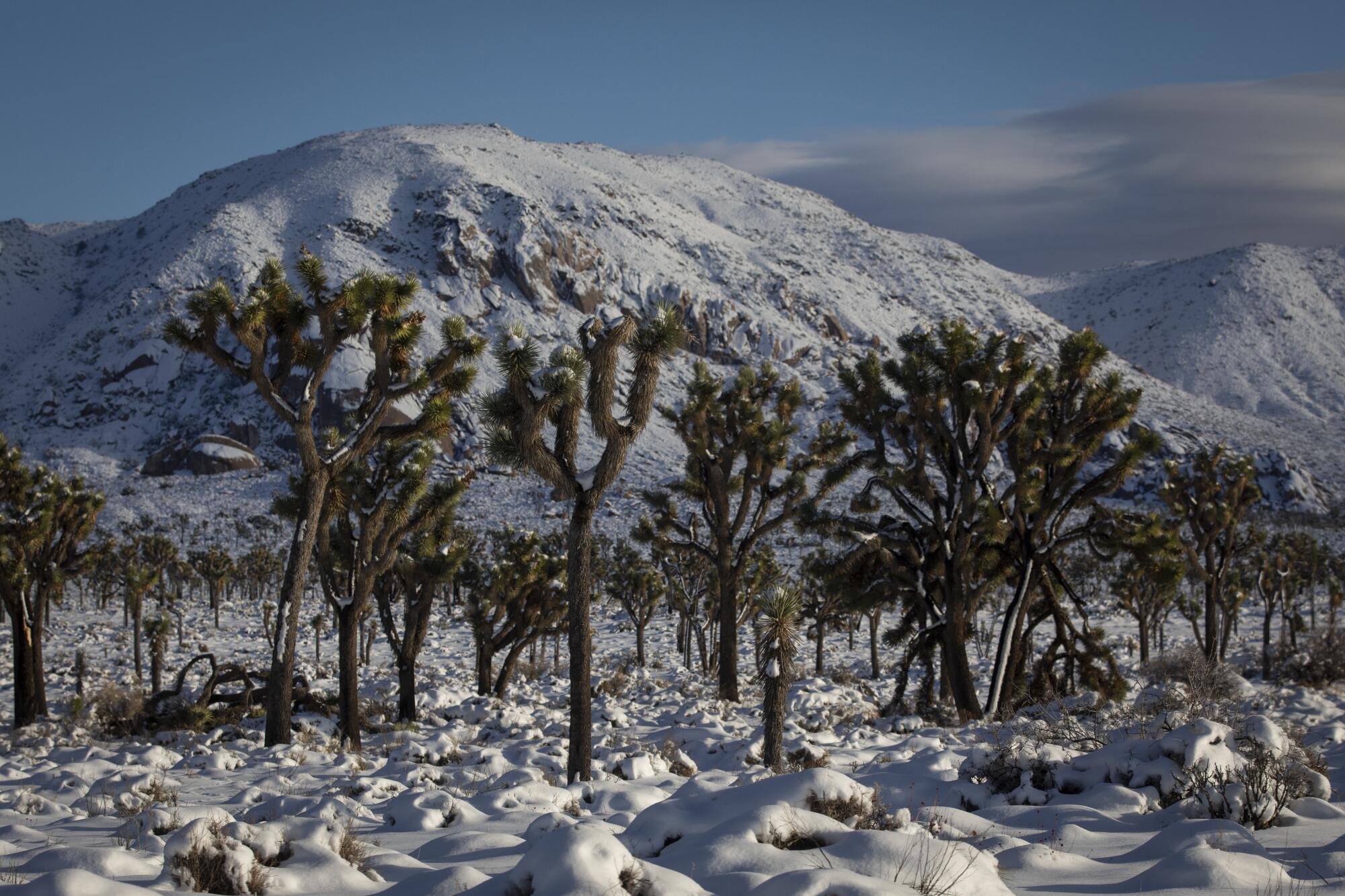
Last year, Usher commissioned artist Molly Keen to paint a mural on the restaurant’s outside wall, and asked that Tripod be included. The end result was a stylized desert scene — ocotillo- and cholla-studded hills rendered in shades of rust, beneath a psychedelic sky. Tripod stands on a road, gaze forever fixed on traffic passing the mural. The image has become a sort of Easter egg for local residents, and a popular spot to take pictures.
“I think there’s a certain toughness that the people locally identify with,” Usher said.
Coyotes are considered to be among the ultimate survivors — they can eat just about anything, from seed pods to squirrels to the remnants of someone’s picnic. Their strength is adapting to whatever opportunities arise, including people and the handouts they give.
Yet wildlife experts say that feeding coyotes is the worst thing you can do for them, and Vamstad has tried to encourage park employees to honk their horns or shout at Tripod to discourage the coyote from getting up close and personal with visitors.
While coyotes are not known to intentionally attack humans, animals who are fed come closer to people, Vamstad said. He posed this scenario: a 6- or 7-year-old visitor is holding a stick of beef jerky. The child walks around the side of a car. All of the sudden, a coyote is there.
“Now you have a potentially ugly situation,” Vamstad said. “I doubt a coyote would ever attack the kid, but it would go after that piece of beef jerky and if it misses — oh God.”
Rick Boyd, animal control supervisor for the city of Twentynine Palms, said he has been told that people are feeding Tripod.
“A lot of it is out-of-towners and they’re just giving it food out their car window, almost like a petting zoo type thing or a safari where you can feed the animals out of your car,” Boyd said.
“But it’s getting bad now because Tripod is begging — sitting on the side of the road waiting, and as cars slow down, it’s walking up to cars for a handout.”
Tension between residents and coyotes is an archetypal Southern California story, especially in places where development has pushed swiftly into the animals’ habitat. Coyotes are clever hunters. They’ve been known to scale or dig beneath fences to prey on pets. But Twentynine Palms is surrounded by expanses of wilderness so vast that it’s hard to forget this is primarily the coyotes’ world that people are living in — not the other way around.
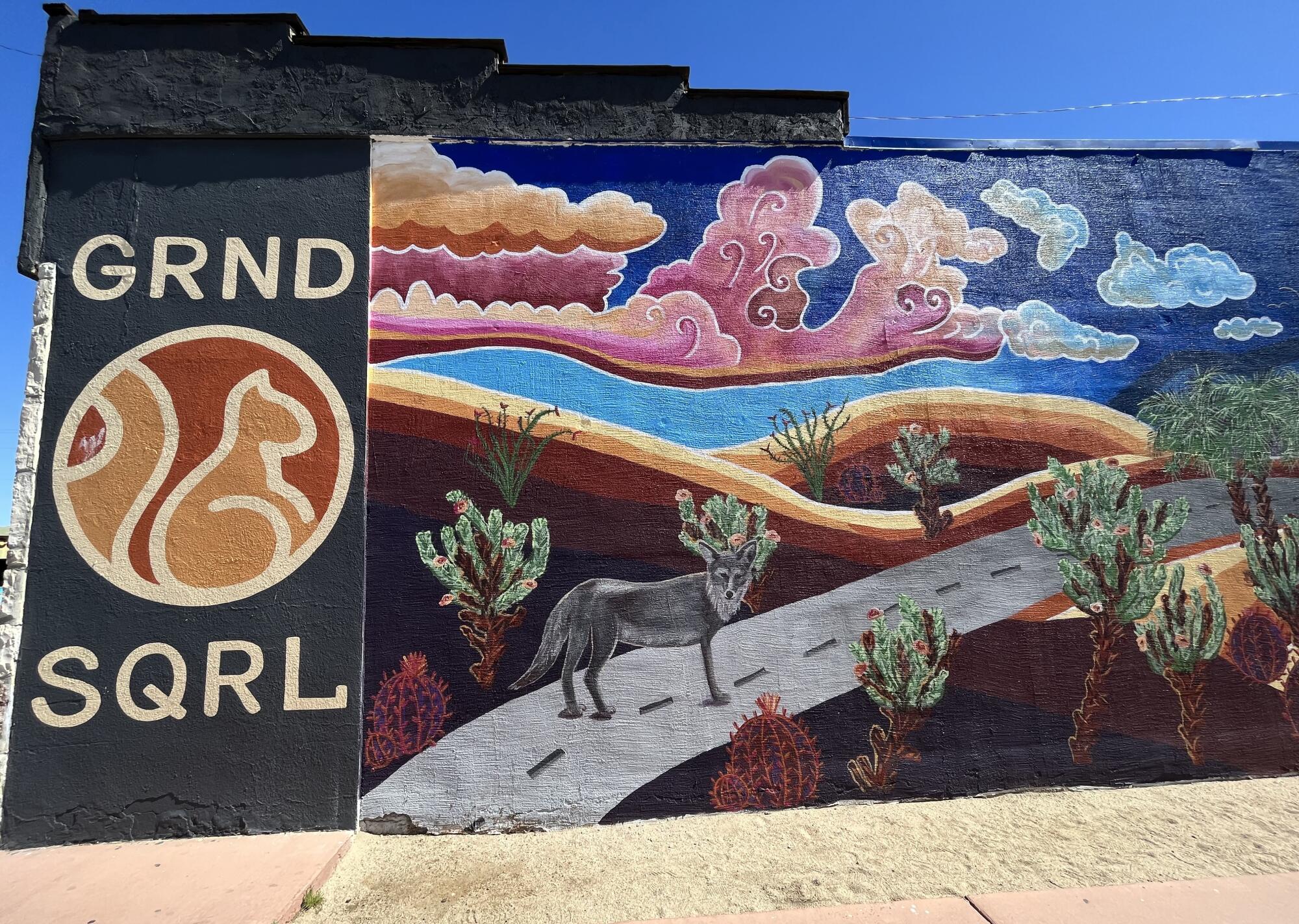
“The main problem that we have is when people come up here and move up here from other areas,” Boyd said.
Visitation to the national park spiked in the years following the onset of the pandemic, surpassing 3 million people for the first time in 2021. Short-term housing rentals proliferated. The town also saw a boom in new residents, as workers became untethered from offices and moved from urban areas to quieter places.
These visitors and newcomers don’t always know the unwritten rules of living in the desert, locals say. They let their cats out. They don’t bring their dogs in at night. They don’t lock up their trash. And they feed the wildlife.
“In my neighborhood, there are a couple houses that always seem to have two to three coyotes in the yard because they’re putting out food and water for them,” Daly said.
“I’m sure they mean well, but by feeding or watering these animals, you are breaking that fear of humans. And they are going to be more in our neighborhoods and in our yards, which puts pets at risk.”
After two mountain lions who were transplanted to the Mojave Desert died of starvation, California wildlife officials have revised their relocation policy.
Feeding coyotes also draws them away from their pack and teaches them not to hunt, Boyd said. That means if they have pups, they can’t provide for them or teach them to provide for themselves. The young ones just starve to death, he said.
“Everybody knows about Tripod, everybody loves Tripod,” he said. “But what I try to tell people is if you love Tripod, leave Tripod alone.”
Part of Tripod’s magnetism appears to be the healthy dose of mystery that surrounds the animal’s existence.
For example, nobody can say for sure whether Tripod is male or female. Locals tend to think Tripod is female, but no one who spoke with The Times has reviewed definitive evidence either way. Others believe the coyote is far older than it appears.
Some residents point to an actor who learned of a pregnant three-legged coyote when he was in town for a film shoot roughly 17 years ago and wrote an essay about how the animal moved him to think of his own misfortunes as less dire.
“It’s a whole lot easier to accept my choices in life, when put into context to that of the real life and death struggles of that wonderful, and very pregnant three-legged coyote, that didn’t have a choice,” Marshal Hilton posted on Booksie, an online publishing platform, in 2007.
A three-legged coyote was known to visit the Marine base in 2008 and 2009, said Carl Dufault, 32, who lived there at the time. Everyone figured the coyote had been struck by a vehicle and survived, he said.
“The whole joke was knowing how the Marines drive, someone probably hit it with a tank,” Dufault said. “So we called it Lucky.”
Dufault suspects it’s the same coyote people are now calling Tripod.
Vamstad doubts that however. Coyotes have a lifespan of about 10 to 15 years, similar to a medium-sized dog, he said. Tripod shows no visible signs of aging, like the graying muzzle and scraggly coat one might expect of an older coyote.
Besides, the wildlife biologist has never seen evidence of Tripod being pregnant or nursing pups, which may in itself be a good indication that the coyote is a male, he said.
It’s a rarely discussed problem, but dogs are the No. 2 predator of livestock in the U.S. In California, roaming dog packs have even killed a human.
Some have offered a mystical explanation for why three-legged coyote sightings have stretched across decades.
“In my family, I kid with them and tell them it’s a sprite, a ghost,” said Steve Troxel, 63, a Navy engineer who saw Tripod when he was bicycling through Twentynine Palms two years ago. “She silently came in and out of my life for a short period of time.”
He said Tripod crossed directly in front of him as he pedaled up a steep hill, so he stopped and climbed off his bike. The two studied one another for about five minutes. Then, like a mirage, the coyote disappeared back into the desert.
But Boyd, the animal control officer, has another theory — there have been a lot of three-legged coyotes roaming Twentynine Palms over the decades.
“We’ve had a few ‘Tripods,’” he said. “This one has just gained momentum.”
To illustrate his point, he lifted a rusty contraption from a bookshelf in his office. A heavy chain dangled from its thick mechanical jaws.
“How we see the three-legged is from people putting these bear traps out,” Boyd said.
Although the traps are illegal, he’s seen coyotes dragging them around. They’ll chew a limb off to free themselves, he said.
“Coyotes are resilient. They’re very, very smart animals,” he said. “If they get hit by a car, break a leg, they’ll gnaw it off. If it’s turning into an infection, they’ll gnaw it off.”
Some years ago, a three-legged coyote who animal control officers called Kickstand lived near the town’s bowling alley, he said. The officers checked on the coyote a couple times and would see Kickstand with the rest of the pack, who helped it hunt for food. The coyote didn’t appear to have any trouble keeping weight on.
That’s the kind of life Boyd would like to see for Tripod.
Toward a more sustainable California
Get Boiling Point, our newsletter exploring climate change, energy and the environment, and become part of the conversation — and the solution.
You may occasionally receive promotional content from the Los Angeles Times.

